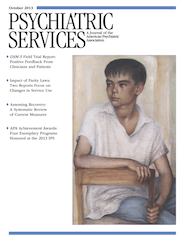Axis V: Essential Supplement to the DSM-5: In Reply
In Reply: Dr. Kennedy and Dr. Aas bemoan the loss of axis V in DSM-5, stating that its “genius . . . has been its focus on global measures of functioning within diagnoses and across all diagnoses to assess outcome of treatment.” They list certain instruments, including the GAF, the Mental Illness, Research, Education and Clinical Center GAF (MIRECC GAF), the Social and Occupational Functioning Assessment Scale, and the Kennedy Axis V, all with similar anchor points, rating instructions, and scoring continua, as preferable to those offered in Section III of DSM-5. We believe that they overstate the advantages of clinician-rated global scales and minimize the advantages of the DSM-5 measures.
A major concern with the GAF and similar instruments is the paucity of evidence that they are reliable in routine practice settings, where training may be variable or nonexistent (1). Training enhances reliability, but rater drift is inevitable without the regular monitoring that is done in research studies. There is also evidence that in routine interviews the GAF is scored on the basis of diagnosis and symptom severity rather than on social and occupational disability and that these ratings are of questionable value in predicting treatment outcome (2). This problem is ameliorated by the use of separate subscales for these domains in the MIRECC GAF and the Kennedy Axis V. Therefore, it is puzzling that Dr. Kennedy and Dr. Aas advocate the use of a global score, which, even with good training and accurate scoring, tells us nothing about why a patient is doing poorly, getting better, or getting worse, because symptoms and disabilities do not predictably covary (3).
The DSM-5 cross-cutting symptom assessments and the World Health Organization Disability Assessment Schedule (WHODAS) represent efforts to “unpack” the elements of the axis V global score for users of DSM-5. These measures represent good targets for assessing treatment outcomes. They can be used across diagnostic categories, require no formal training, and have demonstrated reliability (4,5). The domains measured in the cross-cutting symptom assessments, such as depression, anxiety, sleep disturbance, somatic symptoms, suicidal ideation, and substance misuse, may be a part of the clinical presentation of virtually any patient, regardless of diagnosis. The WHODAS, based on the WHO International Classification of Functioning, Disability, and Health, is applicable across all health conditions. These are patient-completed instruments, although the assessment procedure used in the DSM-5 Field Trials specified clinical review and interpretation of patient responses.
There is no arguing that the GAF has been widely used clinically and in research and has been emulated by several other measures. However, in a health care climate that increasingly emphasizes patient-reported outcomes, measurement-based treatment decisions, and quality-of-care metrics, the use of axis V global measures of “functioning” for our patients is outdated and was properly abandoned by the DSM-5 Task Force.
1 : Are GAF scores reliable in routine clinical use? Acta Psychiatrica Scandinavica 115:326–330, 2007Crossref, Medline, Google Scholar
2 : Global Assessment of Functioning ratings and the allocation and outcomes of mental health services. Psychiatric Services 53:730–737, 2002Link, Google Scholar
3 : Remission in depression: definition and initial treatment approaches. Journal of Psychopharmacology (Oxford, England) 20(Suppl):5–10, 2006Crossref, Medline, Google Scholar
4 : DSM-5 field trials in the United States and Canada, Part III: development and reliability testing of a cross-cutting symptom assessment for DSM-5. American Journal of Psychiatry 170:71–82, 2013Link, Google Scholar
5 :



